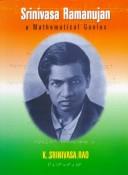Srinivasa Ramanujan FRS (About this sound pronunciation (help·info)) (22 December 1887 – 26 April 1920) was an Indian mathematician and autodidact who, with almost no formal training in pure mathematics, made extraordinary contributions to mathematical analysis, number theory, infinite series, and continued fractions. Living in India with no access to the larger mathematical community, which was centered in Europe at the time, Ramanujan developed his own mathematical research in isolation. As a result, he sometimes rediscovered known theorems in addition to producing new work. Ramanujan was said to be a natural genius by the English mathematician G.H. Hardy, in the same league as mathematicians like Euler and Gauss.[1]
Born in a poor Brahmin family, Ramanujan's introduction to formal mathematics began at age 10. He demonstrated a natural ability, and was given books on advanced trigonometry written by S. L. Loney that he mastered by the age of 12; he even discovered theorems of his own, and re-discovered Euler's identity independently.[2] He demonstrated unusual mathematical skills at school, winning accolades and awards. By 17, Ramanujan had conducted his own mathematical research on Bernoulli numbers and the Euler–Mascheroni constant.
Ramanujan received a scholarship to study at Government College in Kumbakonam, but lost it when he failed his non-mathematical coursework. He joined another college to pursue independent mathematical research, working as a clerk in the Accountant-General's office at the Madras Port Trust Office to support himself.[3] In 1912–1913, he sent samples of his theorems to three academics at the University of Cambridge. G. H. Hardy, recognizing the brilliance of his work, invited Ramanujan to visit and work with him at Cambridge. He became a Fellow of the Royal Society and a Fellow of Trinity College, Cambridge. Ramanujan died of illness, malnutrition, and possibly liver infection in 1920 at the age of 32.

During his short lifetime, Ramanujan independently compiled nearly 3900 results (mostly identities and equations).[4] Nearly all his claims have now been proven correct, although a small number of these results were actually false and some were already known.[5] He stated results that were both original and highly unconventional, such as the Ramanujan prime and the Ramanujan theta function, and these have inspired a vast amount of further research.[6] However, the mathematical mainstream has been rather slow in absorbing some of his major discoveries. The Ramanujan Journal, an international publication, was launched to publish work in all areas of mathematics influenced by his work.[7]
In December 2011, in recognition of his contribution to mathematics, the Government of India declared that Ramanujan's birthday (22 December) should be celebrated every year as National Mathematics Day, and also declared 2012 the National Mathematical Year.[8][9]
Contents
1 Early life
2 Adulthood in India
2.1 Attention from mathematicians
2.2 Contacting English mathematicians
3 Life in England
3.1 Illness and return to India
3.2 Personality and spiritual life
4 Mathematical achievements
4.1 The Ramanujan conjecture
4.2 Ramanujan's notebooks
5 Ramanujan–Hardy number 1729
6 Other mathematicians' views of Ramanujan
7 Recognition
8 In popular culture
9 See also
10 Notes
11 Selected publications by Ramanujan
12 Selected publications about Ramanujan and his work
13 External links
13.1 Media links
13.2 Biographical links
13.3 Other links
Early life
Ramanujan's home on Sarangapani Street, Kumbakonam.
Ramanujan was born on 22 December 1887 in Erode, Madras Presidency, at the residence of his maternal grandparents.[10] His father, K. Srinivasa Iyengar, worked as a clerk in a sari shop and hailed from the district of Thanjavur.[11] His mother, Komalatammal, was a housewife and also sang at a local temple.[12] They lived in Sarangapani Street in a traditional home in the town of Kumbakonam. The family home is now a museum. When Ramanujan was a year and a half old, his mother gave birth to a son named Sadagopan, who died less than three months later. In December 1889, Ramanujan had smallpox and recovered, unlike thousands in the Thanjavur District who died from the disease that year.[13] He moved with his mother to her parents' house in Kanchipuram, near Madras (now Chennai). In November 1891, and again in 1894, his mother gave birth to two children, but both children died in infancy.
On 1 October 1892, Ramanujan was enrolled at the local school.[14] In March 1894, he was moved to a Telugu medium school. After his maternal grandfather lost his job as a court official in Kanchipuram,[15] Ramanujan and his mother moved back to Kumbakonam and he was enrolled in the Kangayan Primary School.[16] When his paternal grandfather died, he was sent back to his maternal grandparents, who were now living in Madras. He did not like school in Madras, and he tried to avoid attending. His family enlisted a local constable to make sure he attended school. Within six months, Ramanujan was back in Kumbakonam.[16]
Since Ramanujan's father was at work most of the day, his mother took care of him as a child. He had a close relationship with her. From her, he learned about tradition and puranas. He learned to sing religious songs, to attend pujas at the temple and particular eating habits – all of which are part of Brahmin culture.[17] At the Kangayan Primary School, Ramanujan performed well. Just before the age of 10, in November 1897, he passed his primary examinations in English, Tamil, geography and arithmetic. With his scores, he stood first in the district.[18] That year, Ramanujan entered Town Higher Secondary School where he encountered formal mathematics for the first time.[18]
By age 11, he had exhausted the mathematical knowledge of two college students who were lodgers at his home. He was later lent a book on advanced trigonometry written by S. L. Loney.[19][2] He completely mastered this book by the age of 13 and discovered sophisticated theorems on his own. By 14, he was receiving merit certificates and academic awards which continued throughout his school career and also assisted the school in the logistics of assigning its 1200 students (each with their own needs) to its 35-odd teachers.[20] He completed mathematical exams in half the allotted time, and showed a familiarity with geometry and infinite series. Ramanujan was shown how to solve cubic equations in 1902 and he went on to find his own method to solve the quartic. The following year, not knowing that the quintic could not be solved by radicals, he tried (and of course failed) to solve the quintic. In 1903 when he was 16, Ramanujan obtained from a friend a library-loaned copy of a book by G. S. Carr.[21][22] The book was titled A Synopsis of Elementary Results in Pure and Applied Mathematics and was a collection of 5000 theorems. Ramanujan reportedly studied the contents of the book in detail.[23] The book is generally acknowledged as a key element in awakening the genius of Ramanujan.[23] The next year, he had independently developed and investigated the Bernoulli numbers and had calculated Euler's constant up to 15 decimal places.[24] His peers at the time commented that they "rarely understood him" and "stood in respectful awe" of him.[20]
When he graduated from Town Higher Secondary School in 1904, Ramanujan was awarded the K. Ranganatha Rao prize for mathematics by the school's headmaster, Krishnaswami Iyer. Iyer introduced Ramanujan as an outstanding student who deserved scores higher than the maximum possible marks.[20] He received a scholarship to study at Government Arts College, Kumbakonam,[25][26] However, Ramanujan was so intent on studying mathematics that he could not focus on any other subjects and failed most of them, losing his scholarship in the process.[27] In August 1905, he ran away from home, heading towards Visakhapatnam and stayed in Rajahmundry for about a month.[28] He later enrolled at Pachaiyappa's College in Madras. He again excelled in mathematics but performed poorly in other subjects such as physiology. Ramanujan failed his Fine Arts degree exam in December 1906 and again a year later. Without a degree, he left college and continued to pursue independent research in mathematics. At this point in his life, he lived in extreme poverty and was often on the brink of starvation.[29]
Adulthood in India
On 14 July 1909, Ramanujan was married to a ten-year old bride, Janaki Ammal (21 March 1899 - 13 April 1994).[30] After the marriage, Ramanujan developed a hydrocele testis, an abnormal swelling of the tunica vaginalis, an internal membrane in the testicle.[31] The condition could be treated with a routine surgical operation that would release the blocked fluid in the scrotal sac. His family did not have the money for the operation, but in January 1910, a doctor volunteered to do the surgery for free.[32]
After his successful surgery, Ramanujan searched for a job. He stayed at friends' houses while he went door to door around the city of Madras (now Chennai) looking for a clerical position. To make some money, he tutored some students at Presidency College who were preparing for their F.A. exam.[33]
In late 1910, Ramanujan was sick again, possibly as a result of the surgery earlier in the year. He feared for his health, and even told his friend, R. Radakrishna Iyer, to "hand these [Ramanujan's mathematical notebooks] over to Professor Singaravelu Mudaliar [the mathematics professor at Pachaiyappa's College] or to the British professor Edward B. Ross, of the Madras Christian College."[34] After Ramanujan recovered and got back his notebooks from Iyer, he took a northbound train from Kumbakonam to Villupuram, a coastal city under French control.[35][36]
Attention from mathematicians
Ramanujan met deputy collector V. Ramaswamy Aiyer, who had recently founded the Indian Mathematical Society.[37] Ramanujan, wishing for a job at the revenue department where Ramaswamy Aiyer worked, showed him his mathematics notebooks. As Ramaswamy Aiyer later recalled:
I was struck by the extraordinary mathematical results contained in it [the notebooks]. I had no mind to smother his genius by an appointment in the lowest rungs of the revenue department.[38]
Ramaswamy Aiyer sent Ramanujan, with letters of introduction, to his mathematician friends in Madras.[37] Some of these friends looked at his work and gave him letters of introduction to R. Ramachandra Rao, the district collector for Nellore and the secretary of the Indian Mathematical Society.[39][40][41] Ramachandra Rao was impressed by Ramanujan's research but doubted that it was actually his own work. Ramanujan mentioned a correspondence he had with Professor Saldhana, a notable Bombay mathematician, in which Saldhana expressed a lack of understanding for his work but concluded that he was not a phony.[42] Ramanujan's friend, C. V. Rajagopalachari, persisted with Ramachandra Rao and tried to quell any doubts over Ramanujan's academic integrity. Rao agreed to give him another chance, and he listened as Ramanujan discussed elliptic integrals, hypergeometric series, and his theory of divergent series, which Rao said ultimately "converted" him to a belief in Ramanujan's mathematical brilliance.[42] When Rao asked him what he wanted, Ramanujan replied that he needed some work and financial support. Rao consented and sent him to Madras. He continued his mathematical research with Rao's financial aid taking care of his daily needs. Ramanujan, with the help of Ramaswamy Aiyer, had his work published in the Journal of Indian Mathematical Society.[43]
One of the first problems he posed in the journal was:













No comments:
Post a Comment